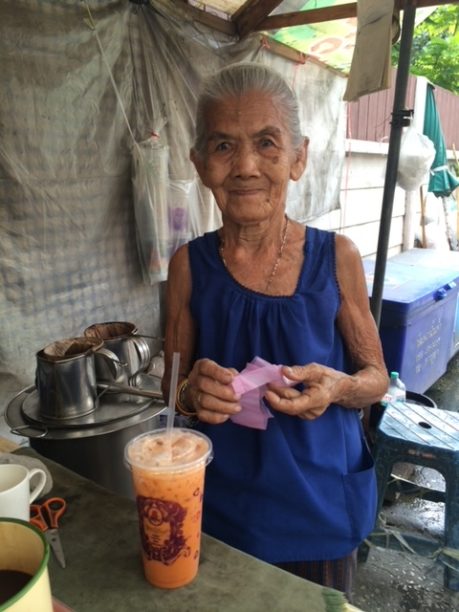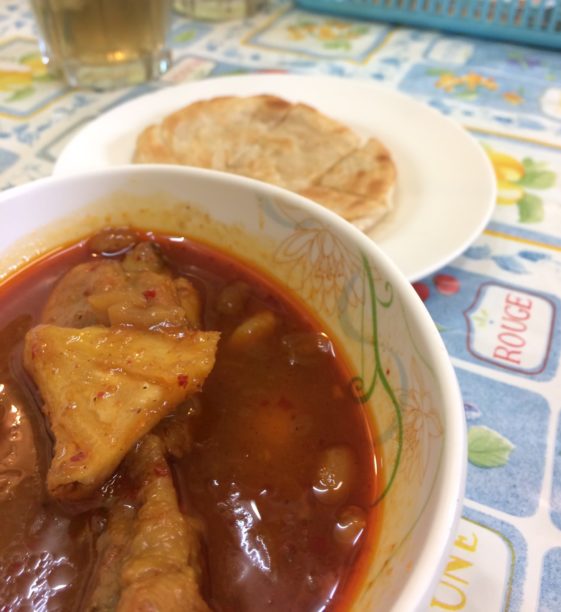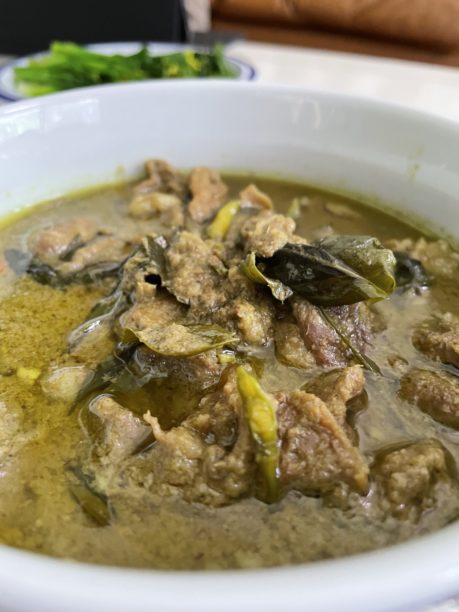I went to the U.S. for a few months, and when I got back, our street was very quiet. I found out that Yai Nang had passed away from Covid the week before I’d returned. When I asked about her funeral and when and where it would be held, her people said they would get back to me, in the Thai way, but they never did. That made sense; it had been a bit intrusive for me, a relative stranger, to ask to attend.

Among the English speakers on our little street, she was known as the “Coffee Lady,” but to all of the Thais, she was Yai Nang, or “Grandma Nang.” For as long as I can remember, Yai Nang was a fixture on the corner across from my house, offering enormous plastic cups of super-sweet Thai coffee or orange-hued teas, filled to the brim with life-saving ice on hot afternoons. On some days, she served glasses of nom yen, iced milk with a drop of nam dang, or red sugar syrup, to the neighborhood children after school. And every day, she was good for a smile, or a wai (Thai greeting).
She was “grandma” to everyone, but 80 years ago, Yai Nang was born Nang Upachan, in Ubon Ratchathani, not far from Thailand’s eastern border. At 16, she moved to Bangkok to work as a maid to a wealthy Thai doctor. Then, she met a gardener and horse groom from a neighboring home and settled down with him.
Seeking more flexible hours and independence, she set up shop selling ice-cold beverages on a corner just 100 feet from her former workplace, in a quiet neighborhood near a canal off of Sukhumvit Road. She ended up spending almost all of her life on that corner.
This neighborhood belongs to the Bunnag family, which claims descent from Sheikh Ahmad, a Persian trader who came to the kingdom of Siam around 1600 and served the royal court in Ayutthaya. Eventually he rose to the level of samuhanayok or royal chancellor, a position many of his descendants would come to occupy. Thai food historians generally credit Sheikh Ahmad with bringing massaman (or Muslim) curry to Thailand.
 Massaman curry.
Massaman curry.Massaman Curry
This curry includes a dried spice base in its curry paste, unlike most Thai curries, whose pastes are based on fresh herbs. This recipe is included in the upcoming book “Real Thai Cooking,” published by Tuttle.
Serves 6 Prep time: 20 minutes Cooking time: 1 hour
Curry Paste
— 10–15 long Thai chilies (diipli) (these are sun-dried & mild) or goat chilies, approx. 9 oz or 250 g
— ½–¾ cup (35 g) dried red chilies of choice, seeds taken out and cut into small pieces
— 1 tsp black peppercorns
— ½ tsp each of mace, cloves and cardamom seeds
— 1 tbsp cumin seeds
— 2 tbsp coriander seeds
— ½ tsp nutmeg
— 2 large shallots or ½ cup (52 g) Thai shallots
— 8 cloves garlic or ½ cup (85 g) Thai garlic
— 1 tbsp coriander (cilantro) root, minced
— 3 tbsp thinly sliced lemongrass, tender inner part of bottom third only, thinly sliced
— 1 inch (2.5 cm) knob of galangal
— 1 tsp shrimp paste, wrapped in foil and heated gently until fragrant
Chicken Massaman Curry
— 1 cup (250 ml) coconut cream (hua kati, or coconut head)
— 4–5 lbs (2 kg) whole chicken, cut into 16 pieces
— 4 cups (1 liter) coconut milk (hang kati, or coconut tail)
— 12 pearl onions, peeled
— 12 small potatoes or 3 large potatoes cut into 4 pieces each
— ½ cup (75 g) raisins
— ¼ cup (60 g) roasted peanuts
— 2 tbsp fish sauce, or to taste
— 1 tbsp shaved palm sugar, or to taste
— 1 tbsp tamarind juice, or to taste
— 2 tbsp bitter orange juice (som saa) (a half and half mix of lime and orange juice may be substituted)
— Red finger-length chilies, sliced, for garnish (optional)
— Coriander leaves (cilantro), for garnish (optional)
— Whole roasted peanuts, for garnish (optional)
Make the curry paste by dry roasting the chilies, peppercorns, mace, cloves, cardamom seeds, cumin and coriander seeds in an oven or on a hot pan until aromatic, about 3–5 minutes. Place the chilies in a mortar and pestle and pound until ground, then add the remaining spices and nutmeg and continue to grind to a fine spice blend. A food processor or spice grinder may also be used.
Next, dry roast the shallots and garlic with skins on in either a pan or oven until the insides are soft. Remove the skins and add the shallots, garlic, coriander root, lemongrass, galangal and shrimp paste to the mortar. Continue pounding until a paste is formed.
In a large pot over medium-high heat, heat the coconut cream until it “breaks” when dots of oil appear on the surface of the cream (or it is reduced by a third). Add the Curry Paste and fry together until aromatic, about 2–4 minutes.
Add the chicken and cook over medium heat until the chicken is partially cooked, approximately 5 more minutes. Add the coconut milk, pearl onions, potatoes, raisins, peanuts and fish sauce, palm sugar, tamarind juice.
Simmer until the chicken and potatoes are just cooked through. Add the bitter orange juice (som saa). Taste again to adjust seasoning. Serve with steamed rice. Garnish with fresh sliced red chili peppers and coriander leaves (optional).
The Bunnag family built a constellation of compounds alongside the breezy canal, with bridges between the various households. The canal brought life, food, friends and guests, like the many others through which Bangkok life flowed, earning the city its nickname as the “Venice of the East.”
But in time the canals were paved over with concrete to accommodate the rise of automobiles. In World War II, Thailand had at first backed the Japanese, and then switched to the Allies, becoming rich and bloated on the postwar boom. Where Yai Nang had once served strolling passersby on foot, she now delivered cold drinks into hands outstretched from car windows, stuck in traffic.
Eventually the Bunnag family fell on hard times, and when the 1997 financial crisis hit, the fine houses along the street were demolished, one by one, to be replaced by towering condominiums. By the time I married into the Bunnag family in the 2000s, and moved into a house on her street, Yai Nang had already spent half a century on the same corner, bearing witness to Thailand’s post-WWII modernization, the financial boom of the 1980s and early 90s, the 1997 bust and baht devaluation, and the string of political crises that followed.
But then as 2020 approached, for the first time in decades, Yai Nang changed, as well; she quit selling her Thai tea and coffee. No one really had a taste for it anymore, she said. Instead, she sold simple soft drinks, packets of instant noodles, eggs, and the occasional bunch of morning glory. Her daughter set up shop next to her, selling a tasty bowl of pork noodles; on the other side, an aharn tham sung (made to order) stall run by her son. The pungent aroma of kaprao (holy basil stir-fry) became my wake-up call, sending me into sneezing fits, a small price to pay for the embarrassment of lunchtime riches provided on our busy corner.
I hope Yai Nang’s funeral was like that of my husband’s grandmother, Yai Nid, an avid cook well-known for her green beef curry laced with ganja (marijuana leaves). Indeed, when she passed away, an eighth of a gram was found in her purse. So at her funeral, a large vat of her green curry was made, with her own “special seasoning” added. Unlike many other Thai funerals, people lingered long after the monks had stopped chanting, dawdling over bowls of curry slathered over fermented rice noodles, well into the evening. I can imagine Yai Nang’s family celebrating her life similarly over cups of her sweet iced coffee.

Green Beef Curry
Serves 4 Prep time: 1 hour Cooking time: 2 hours
Curry Paste
— 1 handful (1/2 cup) shallots
— 1/2 cup garlic
— 3 Tbsp lemongrass, sliced
— 2 Tbsp wild ginger (grachai)
— 2 Tbsp galangal
— 1 Tbsp kaffir lime rind, chopped
— 1 cup holy basil
— 1/4 cup prik chee fah, or green finger-length Thai chilies
— 1 Tbsp bird’s eye chilies (leave some for garnish)
— 1 Tbsp shrimp paste
Green Beef Curry
— 1 kg stewing beef with fat attached
— 1/2 cup baby eggplant (optional, as this tends to water down the curry)
— 2-3 Tbsp palm sugar
— 4-5 kaffir lime leaves, torn (for garnish, optional)
— 3 look jan (nutmeg) and dok jan (mace), ground alongside 1 Tb coriander seed and 1/2 Tb cumin
— 1 Tb salt
— 1 kg coconut milk, separated into “head” (thick creamy top) and “tail” (watery juice)
— a pinch of dried marijuana leaves (ganja, optional)
Stew beef in coconut milk “tail” for one hour.
While beef stews, make paste. Pound galangal and kaffir lime rind with salt. Add lemongrass to mortar and pound. Add chilies, but omit the bird’s eye chilies if you don’t want it too hot. Pound. Add garlic, shallots and wild ginger. Pound into mixture. Add shrimp paste and pound.
Take finished paste and heat in pan with a couple of ladlefuls of the coconut milk used to stew the beef.
Add spice mix (dok jan, look jan, cumin and coriander seeds). Add ganja if using. Wait for the coconut milk to “break” and oil to reach the surface.
Add a few more ladlefuls of coconut milk until you get the consistency you want. Take mixture off heat.
Slice the meat and stir into the pot, with the coconut milk “head” and palm sugar. Add basil and baby eggplants, if using. Garnish with chilies and kaffir lime leaves. Eat with kanom jeen (fermented rice noodles) or roti (Indian flatbread).
An earlier version of this piece appeared at the blog, Bangkok Glutton.






